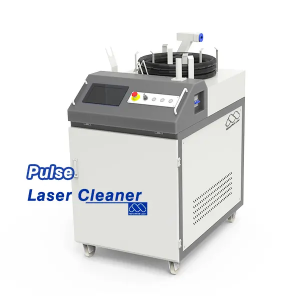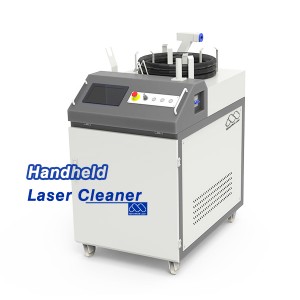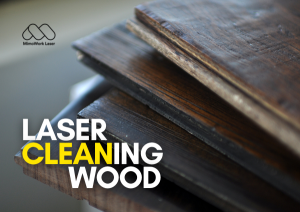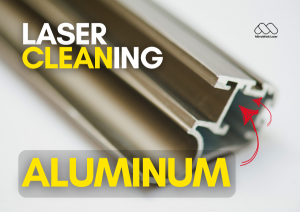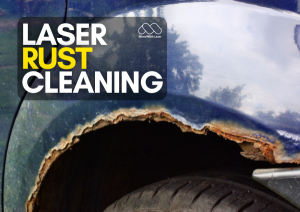What is Handheld Laser Cleaner?
A portable laser cleaning device utilizes laser technology to eliminate contaminants from diverse surfaces.
It is manually operated, enabling convenient mobility and precise cleaning across various uses.
Equipment Overview
Core Components
Cabinet & Laser Generator: The main unit housing the laser source.
Water Chiller: Maintains optimal laser temperature (use distilled water or an anti-freeze mix; tap water is prohibited to avoid mineral buildup).
Handheld Cleaning Head: The portable device directing the laser beam.
Spare Lenses: Essential for replacements if the protective lens becomes damaged.
Safety Tools
Laser safety goggles: protect eyes from beam exposure.
Heat-resistant gloves and a standalone respirator:shield hands and lungs from fumes/particles.
Fume Extractor: Protects both the operator and the machine’s lens from hazardous emissions.
Pre-Operation Setup
Water Chiller Preparation
Fill the chiller with distilled water only. Add anti-freeze if operating in freezing conditions.
Never use tap water—minerals can clog the cooling system and damage components.
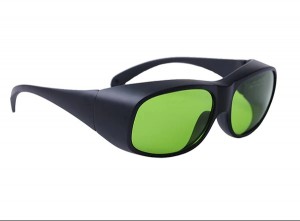
Laser Safety Goggle
Pre-Cleaning Checks
Inspect the protective lens for cracks or debris. Replace if compromised.
Verify the red-light indicator is functional: If the red-light indicator is absent or not centered, it signifies an abnormal condition.
Ensure the main power switch is on before activating the rotary switch. Failure to comply can lead to uncontrolled laser activation and potential damage.
Clear the workspace of bystanders and flammable materials.
Want To Know More About Laser Cleaning?
Start a Conversation Now!
Operating the Laser Cleaner
Initial Steps
Start with manufacturer-recommended presets (power, frequency) for the material being cleaned.
Conduct a test run on scrap material to calibrate settings and avoid surface damage.
Technique Tips
Tilt the cleaning head to minimize harmful reflections.
Maintain a consistent distance from the surface (refer to manual for optimal range).
Handle the fiber cable gently; avoid sharp bends or kinks to prevent internal damage.
Related Videos
How to use Handheld Laser Cleaner
This video shows that different laser-cutting fabrics need different laser powers. You'll learn to pick the right power for your material to get clean cuts and avoid burns.
Are you confused about the power for cutting fabric with lasers?We'll give specific power settings for our laser machines to cut fabrics.
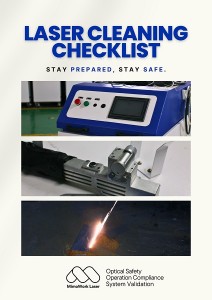
Laser Cleaning Checklist
Free Laser Cleaning Checklist
This checklist is designed for laser cleaning operators, maintenance technicians, safety officers, and service providers (e.g., industrial, conservation, or third-party teams).
It outlines critical steps for pre-operation checks (grounding, lens inspection), safe practices during use (tilt handling, cable protection), and post-operation protocols (shutdown, storage), ensuring compliance and safety across applications.
Contact info@minowork.com to get this checklist for free.
Post-Cleaning Shutdown Routine
Post-Use Inspection
Check the protective lens again for residue or wear. Clean or replace as needed.
Attach the dust cap to the handheld head to prevent contamination.
Equipment Care
Neatly coil the fiber cable and store it in a dry, dust-free environment.
Power down the laser generator and water chiller properly.
Store the machine in a cool, dry location away from direct sunlight.
Key Safety Reminders
1. Always wear protective gear—goggles, gloves, and a respirator—are non-negotiable.
2. Never bypass the test phase; improper settings can damage surfaces or the laser itself.
3. Regularly service the water chiller and fume extractor to ensure longevity.
4. By adhering to these protocols, you’ll maximize the efficiency of your handheld laser cleaner while prioritizing safety and equipment durability.
FAQs
Laser cleaning is a more effective, safer, and superior technology compared to conventional cleaning methods.
Also termed as laser paint stripping and laser coating removal, this method is suitable for all kinds of metals, with steel, aluminum, and copper being the most common.
A variety of coatings can be removed, such as paint, powder coating, e-coating, phosphate coating, and insulating coating.
Laser cleaning machines effectively clean materials like wood and aluminum.
For wood, lasers target just the surface layer, preserving the material's integrity and appearance, which is great for delicate or antique items.
The system can also be adjusted for different wood types and contamination levels.
When it comes to aluminum, despite its reflectivity and tough oxide layer, laser cleaning can overcome these challenges to effectively clean the surface.
Recommend Machines
Related Articles
Post time: Apr-27-2025


